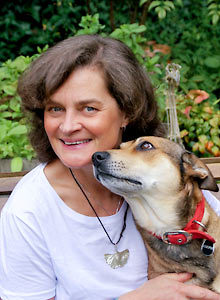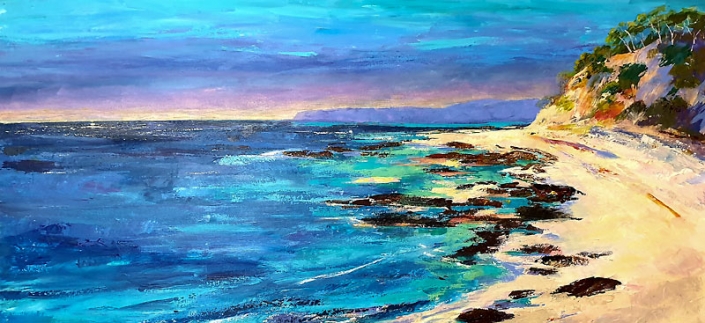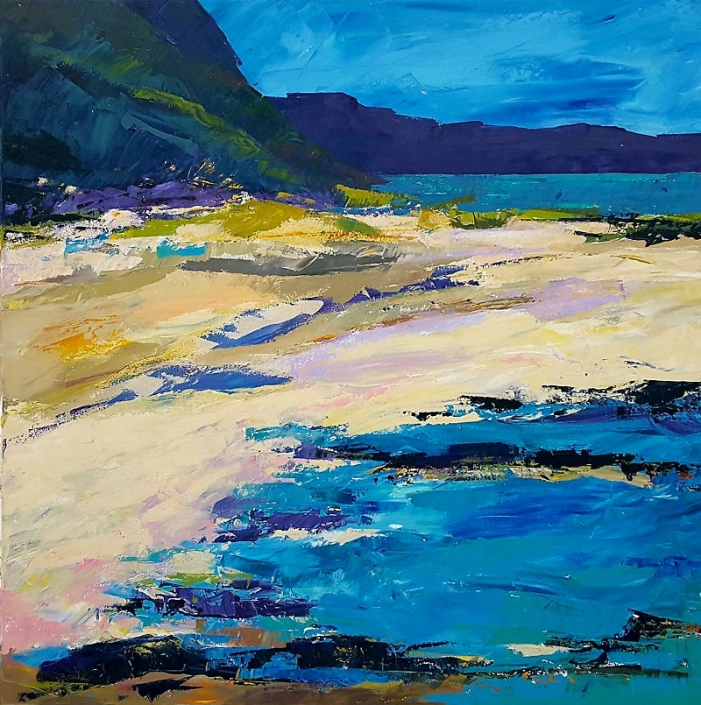Catherine Hamilton

Catherine Hamilton is now living and working on the Mornington Peninsula, in Victoria, Australia, after moving from the UK in 2001. She has exhibited in a number of mixed and solo shows in the UK and Australia.
Style
Catherine is an established artist known for her colour and broad and innovative strokes, often using music or her writing to create the initial concepts and palette.
Her work is distinctive, bold, vibrant and full of energy. She works in various media but pushes the boundaries in diverse exploratory and original techniques. She uses the medium to create unusual effects using glazes and applying the paint with various brushes, rollers, palette knives and more.
“Working on my pieces is an evolution. When I work, the start of a piece becomes the finish. The most important part of working on a painting or drawing is the journey, not thinking too much, keeping in flow and just allowing the concept to develop.”
Inspiration
“Much of my work is produced from recollections – recollections of experiences, emotional responses and visual memory. This particularly applies to my portrait and landscape works. My work is often spontaneous. I like to work from memory, whether it is a face or a place, a journey or an experience. I push my own boundaries, creating difficulties to solve within the work.”
Catherine often puts together small sketches using pencil, charcoal or pen and ink, initially worked from life.
- She makes a record of the colours; collecting colours from the landscape; the seashore;
- She will set up an unusual still life to create ideas;
- She writes about time and place; maybe feelings and emotion; a response to the subject;
- On occasions Catherine uses a camera. The photos become a means of jogging her memory rather than an image to copy from.
A limited palette
Catherine is a colourist. She works in acrylic or oil, sometimes applying the paint in various layers of glazes and transitions of colour. She always selects a limited palette, usually of three tubes of paint plus white. Colour and colour mixing come naturally to her, and almost all of her paintings are worked in this limited palette but often use a transparent red or transparent yellow oxide to wash over the canvas before she starts.

PAS tutor Catherine Hamilton demonstrating mixed media techniques
The discipline of using so few colours, of working quickly, wet into wet, to create each mix on the canvas, almost translates the physics of colour itself, with just the three tubes being mixed to develop a fuller palette of harmonious colours.
Catherine works on each painting from working quickly from start to finish, keeping the paint pliable and workable to create the shifting nuances of colour and tone. She pushes the limits of both medium and colour, applying various and numerous glazes to create texture and depth.
Contact Catherine
0419 519 760 or hamilton-arts@hotmail.com
Artwork by Catherine Hamilton
Spontaneous mark making
Catherine creates marks using broad brushes and palette knives and makes spontaneous marks by dipping the fine ends of sticks to apply the paint. Scumbling and splattering create the fragmented marks of paint.
Painting the colour and rhythm of music
Music is a vitally important part of Catherine’s painting. She chooses to listen to compositions that conjure up a visual, personal intimacy to her works. Indeed, music has a strongly visual component for her that, with the painting, can bring together sight and sound and keep the work in flow.
She experiences synaesthesia, the ability to see colour in music. This becomes an intimate link from subject to colour to music. The palette is totally created from the music itself. The undulations and rhythm of the music create a pulse to the painting process.
Influences
Through studying the work of several masters of painting Catherine has gained much insight and inspiration, plus an understanding of, and appreciation for, the use of colour and light.
- Delacroix – his use of colour;
- Monet’s, a conceptual impressionistic artist who created great works around the subject of water lilies;
- Van Gogh, Turner, Rembrandt and Singer-Sargeant;
- Today’s great masters such as US artists David Leffel and Richard Schmidt;
- UK painters Ken Howard and Ken Paine, from whom Catherine learned personally.
Catherine believes her studies have instilled a confidence in her that enables her to work from a purely emotional response to her subjects, rather than thinking too much about replicating a precise scene.
Visit Catherine’s website for more information or to see more of her artwork.







 Leoni Jenkin
Leoni Jenkin Leoni Jenkin
Leoni Jenkin